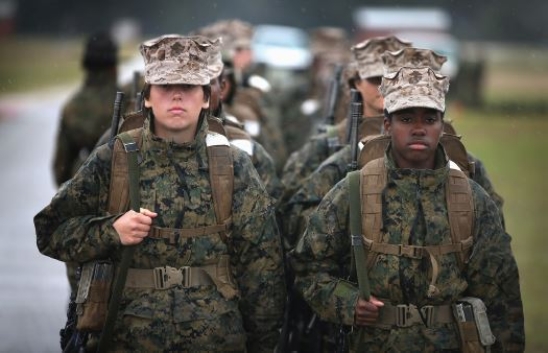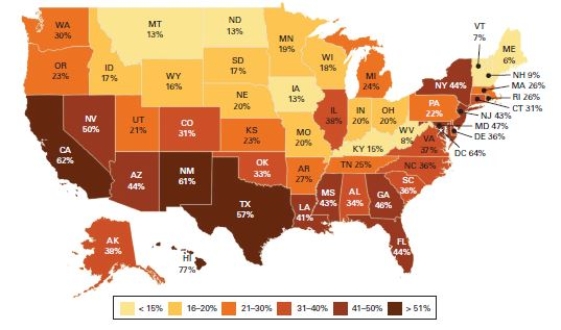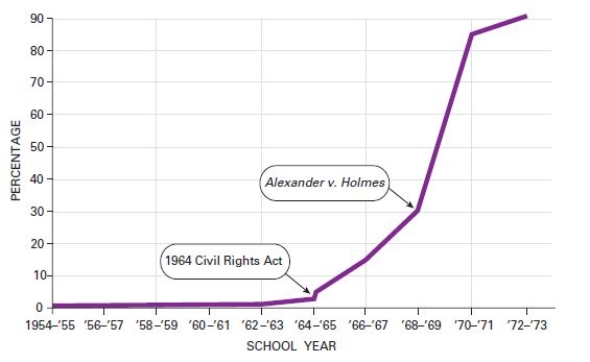A) only Congress could ban slavery -Consider This: The Court's decision in this case helped push the country towards a civil war.
B) black men were citizens but black women were not
C) the Missouri Compromise was unconstitutional
D) slavery was immoral but necessary
F) B) and D)
Correct Answer

verified
Correct Answer
verified
Multiple Choice
If a group of people were systematically discriminated against in the past,which of the following would constitute an affirmative action policy designed as a remedy to help the members of this group overcome this legacy of discrimination?
A) a hiring policy that favors those with relatives working in government
B) a college admissions policy that gives preferential treatment to members of the group
C) a color-blind job application process to give members of this group an equal chance -Consider This: The Court has narrowed the scope of affirmative action policies but allows them if they are 'narrowly tailored' and needed for a 'compelling governmental interest.'
D) requiring that all job applicants have at least two years of prior experience
F) A) and B)
Correct Answer

verified
Correct Answer
verified
Multiple Choice
What did Jim Crow laws mandate?
A) property qualifications
B) racial segregation
C) poll taxes -Consider This: The Supreme Court affirmed Jim Crows laws in the nineteenth century by interpreting the Fourteenth Amendment very narrowly.
D) grandfather clauses
F) A) and D)
Correct Answer

verified
Correct Answer
verified
Multiple Choice
Why did Congress pass the Voting Rights Act of 1965?
A) the Supreme Court had determined that only the national government could regulate elections -Consider This: Despite the Voting Rights Act,each state is still largely in control of the voting rules within that state.
B) because it was clear that many areas in the South had no intention of living up to the spirit of the Fifteenth Amendment
C) because Congress was afraid the Reverend Martin Luther King Jr.would lead a boycott of white businesses if the legislation was not passed
D) to prevent the race riots from spreading from African American neighborhoods into traditionally white neighborhoods
F) All of the above
Correct Answer

verified
Correct Answer
verified
Multiple Choice
 Credit: Scott Olson/Getty Images News/ Getty Images
-Which of the following changes does this photo reflect?
Credit: Scott Olson/Getty Images News/ Getty Images
-Which of the following changes does this photo reflect?
A) There are an equal number of male and female military generals.
B) Women are part of the regular armed services,rather than separate units.
C) Both men and women must register for the draft.-Consider This: Though the image shows soldiers it doesn't indicate anything about the draft.
D) Women are permitted in the army,but not other branches of the military.
F) A) and C)
Correct Answer

verified
Correct Answer
verified
Multiple Choice
What was the primary objective of the women's suffrage movement?
A) broad gender equality -Consider This: Advocates had hoped this would be included in the Fifteenth Amendment but they were ultimately disappointed by Congress.
B) the right to own property
C) equal pay for equal work
D) the right to vote
F) A) and C)
Correct Answer

verified
Correct Answer
verified
Multiple Choice
Which group's civil liberties were affirmed by the Supreme Court's decision in Lawrence v.Texas (2003) ?
A) disabled Americans
B) Asian Americans -Consider This: Liberties for this group were further expanded following the Obergefell v.Hodges decision.
C) American Indians
D) gays and lesbians
F) None of the above
Correct Answer

verified
Correct Answer
verified
Multiple Choice
Which of the following is an example of de jure segregation?
A) Jim Crow laws
B) the tendency for churches to be racially homogeneous -Consider This: Recall that de jure discrimination is contrasted with de facto discrimination.
C) the small number of African American senators
D) sequestering the jury in order to ensure a fair trial
F) B) and D)
Correct Answer

verified
Correct Answer
verified
Multiple Choice
What strategy did the National Association for the Advancement of Colored People (NAACP) successfully use to fight against school segregation?
A) boycotts -Consider This: The civil rights movement used a variety of methods to combat discrimination but the NAACP was very effective using this tactic.
B) protests
C) litigation
D) marches and rallies
F) B) and D)
Correct Answer

verified
Correct Answer
verified
Multiple Choice
What is the status of affirmative action in college admissions after the Supreme Court decisions in the two cases involving the University of Michigan,Gratz v.Bollinger (2003) and Grutter v.Bollinger (2003) ?
A) Affirmative action policies are generally permissible,but they cannot involve race-based quotas or numerical point systems.
B) Affirmative action policies are assumed to be unconstitutional unless the university can demonstrate the need to promote racial tolerance.
C) Affirmative action policies must ensure that all racial and ethnic groups are represented in accordance with the population of the nation as a whole.
D) All forms of affirmative action are unconstitutional because they unfairly favor some people over others based on the color of their skin.-Consider This: The Court has ruled that promoting diversity is a legitimate government objective.
F) B) and D)
Correct Answer

verified
Correct Answer
verified
Multiple Choice
Which of the following was the Civil Rights Act of 1964 designed to overturn?
A) integration
B) Jim Crow laws
C) nonviolent resistance
D) Reconstruction -Consider This: This major piece of legislation followed the Brown v.Board of Education decision.
F) A) and C)
Correct Answer

verified
Correct Answer
verified
Multiple Choice
The Fifteenth Amendment guarantees citizens the right to vote regardless of __________.
A) race
B) economic status
C) involvement in insurrection
D) property ownership -Consider This: The primary purpose of the Civil War amendments (the Thirteenth,Fourteenth and Fifteenth amendments) was to provide legal equality to former slaves.
F) B) and C)
Correct Answer

verified
Correct Answer
verified
Multiple Choice
Why did states enact poll taxes?
A) to raise revenue for the government
B) to ensure that only people who really want to vote would do so
C) to get around the Fifteenth Amendment
D) to enfranchise former slaves -Consider This: To enfranchise means to give a person or a group the right to vote.
F) None of the above
Correct Answer

verified
Correct Answer
verified
Multiple Choice
What did the Supreme Court determine in Adarand Constructors v.Peña?
A) affirmative action policies must be scrutinized using the same suspect standard that is used for other policies classifying people by race
B) affirmative action policies are subject to an intermediate standard whereby they are presumed to be permissible
C) affirmative action policies may be broadly tailored to accomplish a compelling government interest
D) affirmative action policies must be designed to address past discrimination without taking into account race,ethnicity,religion,or creed -Consider This: This decision made it more difficult for the federal government to implement affirmative action programs.
F) A) and C)
Correct Answer

verified
Correct Answer
verified
Multiple Choice
When did the modern civil rights begin?
A) when the Civil War ended -Consider This: The initial civil rights efforts in the United States focused primarily on de jure discrimination but later focused on de facto as well.
B) during Reconstruction with the passage of the 13th,14th,and 15th Amendments
C) in the 1950s with an increase in public policies seeking to foster racial equality
D) immediately prior to the passage of the Equal Rights Amendment
F) A) and C)
Correct Answer

verified
Correct Answer
verified
Multiple Choice
Minority population by state  Source: U.S.Census Bureau,2016.
-Based on the map,why might it be increasingly necessary to address issues pertaining to minority rights?
Source: U.S.Census Bureau,2016.
-Based on the map,why might it be increasingly necessary to address issues pertaining to minority rights?
A) Minority groups felt powerless in the U.S.before the Civil Rights Movement.
B) The Civil Rights Movement's successes did not affect other groups.
C) The minority population is growing in the U.S.,and is the majority in some states.
D) Minority groups have more political power than whites.-Consider This: Though this might be true in the future,a large part of the minority population is children; many minorities also remain disenfranchised.
F) C) and D)
Correct Answer

verified
Correct Answer
verified
Multiple Choice
If you thought you were getting an inferior public education because of your ethnicity,which part of the Constitution would you rely on most heavily to justify your case?
A) the Equal Rights Amendment -Consider This: This amendment,passed shortly after the Civil War,is the cornerstone of modern civil rights law.
B) the Thirteenth Amendment
C) the Fourteenth Amendment
D) the Nineteenth Amendment
F) A) and B)
Correct Answer

verified
Correct Answer
verified
Multiple Choice
According to the Supreme Court's decisions in the Civil Rights Cases (1883) ,in which of the following areas could racial discrimination occur?
A) juries
B) hotels
C) post offices -Consider This: In these cases,the Court found discrimination by individuals and businesses to be acceptable.
D) running for office
F) A) and C)
Correct Answer

verified
Correct Answer
verified
Multiple Choice
How has the Equal Rights Amendment affected women's civil rights?
A) It has ensured that men and women are treated equally in the workplace.-Consider This: The Equal Rights Amendment was initially proposed in Congress in 1923.
B) It has ensured that the courts evaluate gender discrimination using the inherently suspect test.
C) It has eliminated gender discrimination in the military.
D) It has had little effect because it was not formally adopted.
F) A) and C)
Correct Answer

verified
Correct Answer
verified
Multiple Choice
 Source: Data from Lawrence Baum.
-Which of the following contributed to the Supreme Court's decision in Alexander v.Holmes?
Source: Data from Lawrence Baum.
-Which of the following contributed to the Supreme Court's decision in Alexander v.Holmes?
A) the refusal of African Americans to attend school with whites
B) freedom rides
C) de facto segregation
D) de jure segregation -Consider This: De jure segregation was made illegal by Brown v.Board of Education.
F) B) and C)
Correct Answer

verified
Correct Answer
verified
Showing 21 - 40 of 44
Related Exams